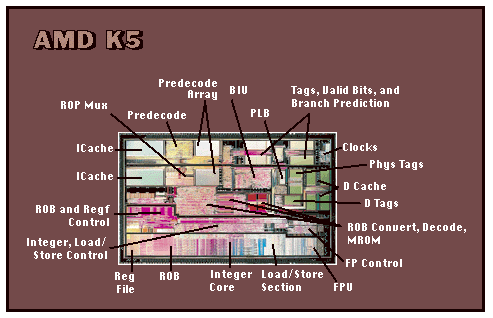| DOSSIER: AMD's reputation is riding heavily on the K5,
the company's first x86 processor to break free of Intel's
designs. The birth of the K5, however, has not been
without labor pains. Originally, AMD planned to ship the K5 in volume this year at clock speeds ranging from 100 to 120 MHz. Instead, only a few thousand K5 chips will trickle out of AMD's foundries in the fourth quarter, and they will be clocked at a conservative 75 MHz. What happened? AMD apparently underestimated how long it would take to verify the K5 (especially after the public furor over the Pentium bug), and the company was overoptimistic about the K5's initial silicon. Missed deadlines and slower clock speeds resulted. But AMD is working hard to catch up. Few, if any, of the K5 chips manufactured this year on AMD's 0.5-micron process will show up in commercially available systems. In the first quarter of 1996, AMD plans to move the K5 onto its new 0.35-micron process technology, which was developed in partnership with HP and is centered in AMD's brand-new Fab 25 in Austin, Texas. That will shrink the K5's 4.2-million-transistor die to about 167mm^2 and allow significantly higher yields. It will also permit faster clock speeds. AMD says its production will ramp up rapidly in 1996, enough for it to ship more than 5 million K5s by the end of next year. According to AMD, clock speeds will rise to 90 or 100 MHz in the first quarter and go beyond 100 MHz after that. AMD hasn't released official SPEC numbers or allowed independent benchmarking, but based on the claim that the K5 is 30 percent faster than a Pentium at the same clock speed, we estimate the performance of a 75-MHz K5 at 109 to 115 SPECint92. That should scale to about 150 SPECint92 at 100 MHz. Even if AMD succeeds in meeting these goals, the K5 will trail high-end Pentiums in raw performance — and then there's the P6. AMD's answer to Intel's sixth-generation CPU is supposed to be the K6, but that's highly unlikely to happen before 1997. Nevertheless, AMD should have no trouble selling all the chips that it can make next year. In addition, the company is putting itself into a better position for the future; it recently purchased a second Quickturn simulator to accelerate its compatibility testing. Meanwhile, AMD will keep its foundries busy by cranking out 486 chips for a declining but worthwhile market. Worldwide 486 shipments are expected to drop from 35 million this year to 20 million in 1996, and AMD hopes to ship most of those. AMD's souped-up 486 chips, clocked at 120 and 133 MHz, will compete with low-end Pentiums in entry-level PCs (see "New 486 Chips Deliver Inexpensive Power," September BYTE). However, the pressure is on AMD to ramp up the K5, because the 486 is quickly dropping off the map. OFFICIAL INTRODUCTION DATE: First Quarter of 1996 CURRENT STATUS: Sampling LIKELIHOOD INTRODUCTION DATE WILL BE MET: Good TARGET CLOCK SPEED: 75 MHz ESTIMATED PERFORMANCE: 109 to 115 SPECint92 FABRICATION PROCESS/FEATURE SIZE: CMOS three-layer metal/0.35-micron TECHNOLOGICAL ADVANTAGES: Four-way superscalar microarchitecture; decoupled RISC-like core; speculative, out-of-order execution. TECHNOLOGICAL DISADVANTAGES: Clock speeds are falling short of initial targets; lengthy compatibility testing has delayed introduction. PRIMARY MARKET: Mainstream desktop PCs. Where to Find:AMDAMD K5 A look at the AMD K5's superscalar
architecture.
Copyright 1994-1998 BYTE |